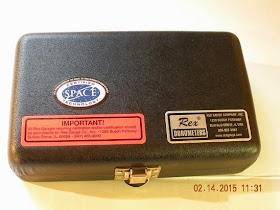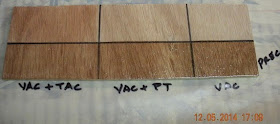That is not actually lead in pencils. It is graphite.
What Graphite Is and Is Not Doing for the Bottom of Your Boat
Graphite is so soft that when you drag it over paper, rather than the graphite scratching the paper, the paper scratches the graphite leaving that black trail known as a pencil mark. If graphite is so soft that even paper scratches it, why do boat suppliers claim that it increases scuff resistance when added to epoxy?
 |
| From page 23 of WEST SYSTEM User Manual & Product Guide |
Mohs Hardness Scale
"Hardness" is the resistance of a material to being scratched. In 1812, Friedrich Mohs, a German mineralogist, developed his hardness scale. He selected ten minerals of distinctly different hardness that ranged from a very soft mineral (talc) to a very hard mineral (diamond). He tested how each scratched one another, or didn't scratch one another, and developed this scale
 |
| Mohs Hardness Scale |
Graphite is fairly soft, about 1.5 on the hardness scale, somewhere between Talc and Gypsum.
Graphite is soft, relatively susceptible to being scratched and not likely to scratch other minerals.
Hardness and Strength
Don't confuse hardness with strength. Hardness and strength are different properties. Diamond is the hardest natural substance known to man but if you put your wife's diamond wedding ring on an anvil and hit it with a sledge hammer, the diamond will be crushed to smithereens. That is part of the reason she divorced me.
The diamond will be crushed to a powder because its compressive strength was exceeded. It failed in compression when the hammer fell. The hammer and anvil are fine because they are made of steel and steel's compressive strength is much higher than the compressive strength of diamond. But if you look closely, the steel hammer and anvil are scratched in the area of the powdered diamond. And if you could look close enough, you will see that the diamond powder has no scratches. That is because diamond is harder than steel. The diamond scratched the steel and the steel did not scratch the diamond.
Hardness and strength are different properties. Hardness is the resistance to being scratched, the resistance to being scuffed.
I tried to explain all this to my future-ex-wife, but she wouldn't stop crying and listen. All she did was look at the anvil and scream, "How could you?"
Epoxy Hardness
Surprisingly to those of us who have toiled at sanding it, epoxy itself is not very hard. It is about the same hardness as copper, around 3 on the hardness scale. However, it is harder than graphite. So, theoretically, it is not physically possible to harden or increase the scuff resistance of epoxy, at a hardness of 3, by adding something at a lower hardness, such as graphite, at a hardness of 1.5.
However, if you have one foot in a fire and one foot in ice, theoretically you are comfortable.
Time for Another of Mo 'Poxy's Experiments
So I mixed up samples of three scenarios:
- Epoxy resin and hardener with about 20% graphite,
- Epoxy resin and hardener with no additive (un-thickened), and
- Epoxy resin and hardener with about 20% silica powder.
 |
| Epoxy with graphite, epoxy and epoxy with silica |
After letting them cure for a few weeks, I stole the durometer from work.
 |
| Rex durometer's way cool case |
 |
| Rex model 1700 durometer complete with way cool calibration certificate |
I used the durometer to measure the hardness, on the durometer scale, of each scenario. For each scenario, I took several durometer measurements, at clock positions 0:00, 1:30, 3:00, 4:30. 6:00, 7:30, 9:00 and 10:30.
The Moment You Have All Been Waiting For...
Data Please
For the graphically inclined...
The first thing I notice is that I am pushing the limits of the durometer. It's scale is 0 to 100 and all of the measurements were over 96. However, when I used the durometer on a glass beer bottle, I spilled beer in my lap. The glass pegged the durometer's meter at 100 so the epoxy scenarios are not as hard as glass and the durometer is sensing the difference between glass and the epoxy scenarios.
The next thing I noticed is that there is very little difference in hardness between the three scenarios. Yes, the graphite makes the epoxy a hair softer. Yes, silica (silica is quartz and has a Mohs' hardness of 7) makes the epoxy a hair harder. But the difference is pretty much negligible.
So I employed Moh's method. I attempted to scratch each scenario with the other two. In no case did any of the scenarios scratch the others. This indicates that they are all about the same hardness.
As a boat building geologist pointed out, you really can't increase the hardness of epoxy with an additive that is only 20% of the whole. The result is still 80% epoxy and will have the hardness and scuff resistance of epoxy, regardless of additive.
Graphite powder does not increase the scuff resistance of your boat bottom.
Time for Another of Mo 'Poxy's Experiments
I prepared a panel with four scenarios
- Un-thickened epoxy,
- Epoxy thickened with graphite powder,
- Epoxy thickened with silica powder, and
- System Three Linear Polyurethane (LPU) topcoat.
After the panel cured for a few weeks, I placed a drop of water on each scenario. Each water drop was the same volume as measured with an eye dropper. The water was dyed green so it would show well on the white panel.
 |
| Test panel with four scenarios |
 |
| Green water and eye dropper |
After placing the water drops, the drops will naturally spread further and have larger area, on the surfaces with less surface tension. The drops will naturally spread less and have smaller area, on the surfaces with more surface tension.
 |
| Water drop on unthickened epoxy. US 25-cent piece used for size reference |
 |
| Water drop on epoxy thickened with graphite |
 |
| Water drop on epoxy thickened with silica powder |
 |
| Water drop on System Three LPU topcoat |
As far as I can tell, the only scenario with a different water drop size is the epoxy thickened with silica. It is a smaller drop area, indicating higher surface tension. I am not surprised since it was the only surface with any roughness despite the fact that I sanded it vigorously with fine sand paper.
Graphite powder does not decrease the friction of your boat bottom.
So why the hell am I dealing with the mess of the black graphite powder and the even messier sanding of graphite-thickened epoxy?
Call me a heretic and charge me with blasphemy but I'm not dealing with graphite powder anymore, with one exception...
I think the graphite powder has value as a pigment. It creates an opaque epoxy layer and is a lot more effective at pigmenting epoxy than epoxy pigment which is not opaque and requires multiple coats. Due to the minimal direct sunlight at latitude N61° and the presence of a UV inhibitor in my epoxy hardener, I am not worried about UV exposure. A boat bottom top coated with graphite powder-thickened epoxy will be pretty, shiny and easy to maintain. There is no primer and no paint. Just slap on some graphite powder-thickened epoxy over your dings and nicks. And, graphite powder thickens the epoxy, reducing the likelihood of runs in the top coat.
The only use I see for graphite powder is as a pigment and thickener for a top coat.






















